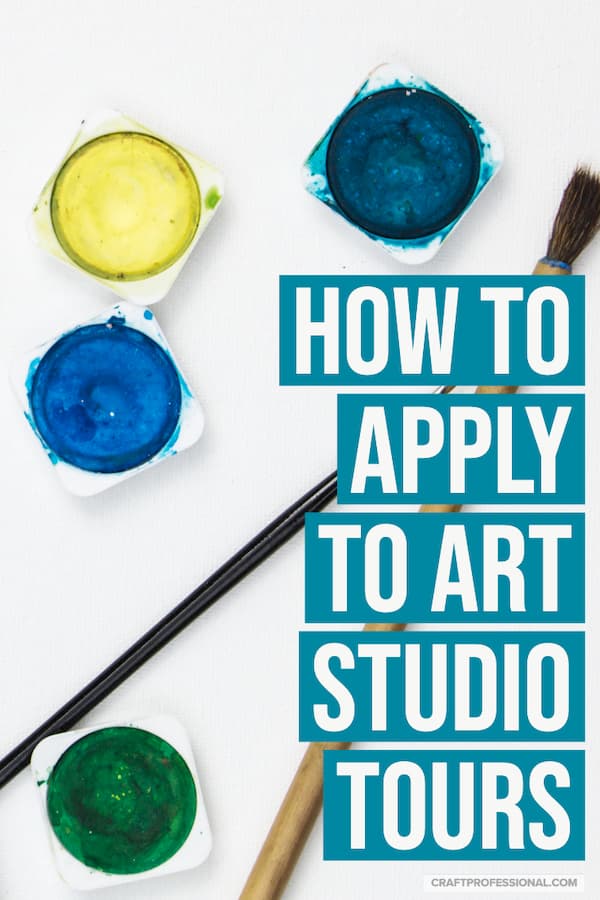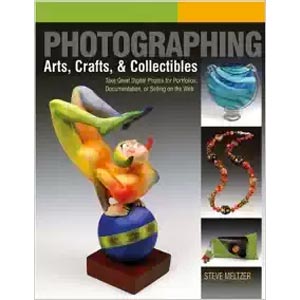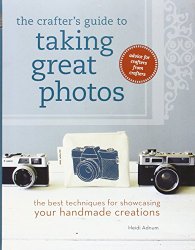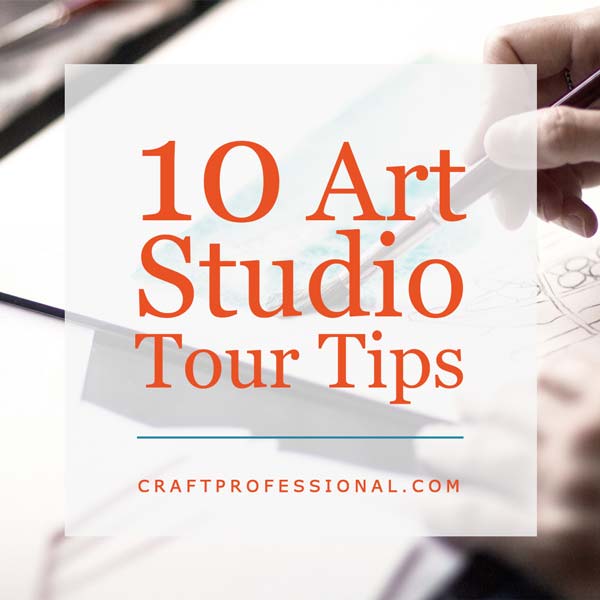Applying to Artist Studio Tours
Artist studio tours can provide excellent opportunities to introduce yourself and your work to people who have a real appreciation for art and handmade items. Opening your studio doors to the public can help foster the connections that people who buy handmade appreciate.
Studio tour applications may look intimidating, but you can boost your chances of being accepted by using some straightforward strategies.
Artist Studio Tour Overview

Open studio events are generally organized by a local artists' association or guild. They are typically held in the spring or fall when other sales opportunities are more limited.
Participating in a local spring open studio in April or May can provide you with a welcome opportunity to connect with customers at a time when sales can be slow. Likewise, fall art tours generally run in September or October, when summer craft shows have wound down for the year, and Christmas sales have not yet fully begun.
Open studio tours are normally juried, which means there's a process in place for assessing applicants' work before they are accepted to the tour, and not everyone is accepted.
The jurying process ensures the quality of the work represented on the tour is high and everything is handmade. And, in the case of studio tours, jurors will also assess your studio space to ensure it is appropriate and safe for the general public to visit.
If you are not sure whether participating in an open studio event is right for you, try to attend a studio tour as a customer first so you get a feel for it.
Do keep in mind, though, that studio tour applications need to be submitted well in advance of the actual event date. Be sure to check the application deadline for any tour you are considering so you don't miss the deadline while you are making the decision.
To find out if there is an open studio tour in your area and when applications are due, simply check with your local artists' association. If you can't find the details you need on their website, you can contact them directly to ask about application deadlines.
Get on their mailing list and follow their social media accounts, so you'll get their news. Subscribing to newsletters is a more reliable way to stay informed than following on social media. You won't typically see all social media posts made by an organization you follow, and you're less likely to miss an email message.
I earn a commission for purchases made through links on this page.
To learn more, please see my disclosure.
Applying to an Artist Studio Tour
1. Get the Application Form
Once you've determined that your local art association does organize an open studio tour, check their website for details about the application process.
Alternatively, there may be a specific website dedicated to promoting the open studio tour, and you will often be able to find an application information there.
Keep in mind, if you're on a website dedicated to promoting the studio tour, the site's first job is to promote the event to potential customers. Therefore, the site will be written for customers, and the information for artists to apply will probably not be immediately obvious.
Check the site carefully for information; it may be found in a small, unobtrusive link near the top or bottom of the page.
Most studio tours will provide an application form and instructions for applying right on their site. If you can't find details about how to apply on their site, call the organizers or send an email.
2. Do Not Miss Deadlines!
Check the application deadline!
I can't stress this point enough.
If you are new to the jurying process, you might be surprised by how far in advance you need to apply to participate in a studio tour (the same is true for juried art shows).
Normally, you will need to submit your application approximately 6 to 8 months before the art studio tour. Also, the application process can be fairly involved and may require a lot of work (they get easier once you've completed a few).
You'll regret it if you wait until the last minute to complete your application.
3. Check Your Eligibility to Participate in the Tour
Eligibility requirements to participate in an open studio tour vary from one tour to another, but there are some requirements that are typical for most studio tours.
Fees
There will be a cost to participate in the tour. The price varies widely, but fees often fall in the range of $100 to $400.
Residency Requirement
You may need to live (or have your studio space) in the area represented by the open studio tour. This requirement makes sense, since visitors will be coming out to your home / studio on the day of the tour.
Some studio art tours allow guest artists from out of the area to participate. Normally a guest artist would share studio space with a local artist who is also participating in the tour.
Appropriate Work
Your work must be original and made and designed by you. If some aspect of your work is not handmade by you, you may need to provide details about that aspect of your work, and the jury will decide if your work is appropriate for the tour.
Appropriate Studio Space
You'll need a space that is appropriate for the general public to visit and can accommodate a lot of visitors.
It can be wonderful to be able to give visitors a look at your work space if it's possible. However, not everyone has a work space that is appropriate for the general public.
If you don't have an appropriate studio space, displaying your work in a front room of your home is an option that is acceptable to many studio tour organizers.
Studio Visit
Before you are accepted to the art studio tour, a member of the jury may visit your home and/or studio (wherever you will show your work on the day of the event) to ensure the space is appropriate.
Often this requirement only applies to artists who are new to the tour. Returning artists usually won't need a studio visit from a juror each year they participate in a tour.
Enough Work to Show
You'll need to ensure you have enough work to show to make your studio a worthwhile stop on the tour. Most shows don't specify the number of items you must have simply because it varies depending on the type of items you make.
Vendor's Permit
Depending upon the business laws in your location, you may be required to have and display a vendor's permit in order to participate in art and craft tours.
If you do need a vendor's permit, and you don't have one, visit your closest business development center or Chamber of Commerce. They will be able to tell you how to get a vendor's permit in your area.
Adequate Insurance
Many tour organizers require participating artists to sign a waiver stating the tour organizers have no liability for injury or property damage resulting from the studio tour.
Some organizers require you to provide proof that you have your own adequate business insurance.
Your insurance agent will be able to tell you whether your existing business insurance covers potential issues that may arise.
Be particularly aware that having customers in your home / studio can cause issues with your insurance. If you don't normally have customers in your home / studio, you may not be covered for that event. Be sure to discuss this issue with your insurance agent.
If you are not covered for having customers in your home or studio, your agent may be able to add a simple rider that covers you for the duration of the studio tour.
PLEASE NOTE: I am not an insurance expert by any stretch of the imagination.
You do need to talk to your own agent to assess your needs. A call to your insurance agent will help you to determine whether you have appropriate business coverage for this type of event and learn how to put extra insurance in place if necessary.
4. Complete the Application
Again, requirements will vary, so you need to carefully read the application information for the specific tour that interests you. There are some requirements that are common to most events.
Typically your application will include:
- Your completed application form
- Several photos of your work
- Artist's biography and/or artist's statement
- Proof of insurance
- Check to cover the fee
- Self addressed stamped envelope (if your application is processed by mail and not online)
Your Completed Application Form
Application forms are normally straightforward. Organizers will ask for your basic contact information, the location of your studio, they may ask you to provide directions to your studio, and they may ask you to sign off on certain conditions of participating in the tour.
Be sure to read the application form carefully. It can help to read the form through once before you start answering questions, particularly if you are not clear about the meaning of a specific question.
Several Photos of Your Work
You will need to provide excellent images that show your work in the best possible light. You may also need to submit photos of your studio space.
These photos will be used to determine whether the quality of your work meets the standards for the tour, so they must be exceptional. They may also be used in promotional materials, so you need photos that impress a jury and potential customers.
Read the application instructions carefully to determine exactly what type of photos you need to provide for the jury.
You will probably need to submit somewhere between 3 and 10 images. The jury will almost certainly want digital images; few (if any) show organizers use traditional slides or printed photos. They may ask for images to be downloaded through an online application service, or sent on a USB flash drive, on a CD, or via email.
When submitting digital images, there will be rules about the size and resolution of the photos, and there may be specific instructions for naming each photo.
If there aren't specific rules about how to name each photo, be sure to name each file in a way that makes it easy for jurors to keep track of each image.
Generic file names like photo1, photo2, photo3, will not help the jurors stay organized. Naming your photos with your name and a description of your work - for example, YourName-CeramicVase.jpeg - is more helpful and will put show organizers in a better mood when reviewing your work.
Where to Learn Product Photography Skills
If you aren't sure about photographing your work, you may consider hiring a professional photographer who can take excellent shots for you.
If you're thinking about doing the photography yourself, make sure you know how to take excellent shots.
Here are my favorite resources for learning how to photography your handmade items:
Photographing Arts, Crafts & Collectibles: This book is older than the other resources, but it is an excellent source of information about taking the type of product photos traditionally used for applications to a juried event.
The Crafter's Guide to Taking Great Photos: This book is a fantastic guide for taking lifestyle photos of your handmade items.
Product Photography at Home: This Craftsy course was developed specifically for craft artists and covers everything you need to know to start taking great product photos.
Whatever option you choose, your photographs need to be excellent.
Artist's biography or artist's statement
Artist's statements or biographies are typically used in the studio tour's promotional materials, so you'll want to be thinking about what you want to say to potential customers when you write this statement.
You may be asked to provide a brief (approximately 100 words) statement that will be used in brochures (and can influence whether people choose to visit your studio on the day of the tour), or you may be asked to provide a more detailed description of your work that will appear on websites and other promotional material.
Writing an artist's statement can be challenging. You may need to give yourself a few days to work on this project in order to fully formulate your thoughts and determine the best way to express yourself.
I would suggest starting with brainstorming what you want to say to your customers. Spend time writing and formulating those ideas. Then, once you have written your statement, look at other artists' statements (you'll often find them on artists' websites) for inspiration.
Do not read other artists' statements before you write your own, or you will have a hard time writing in your own words. Use inspiration from others only to polish up a statement that you have written on your own.
Proof of Insurance
You may need to provide proof that you have adequate business insurance to cover any issues that may arise related to the studio tour. Some organizers will specify a specific amount of liability insurance that you need to carry, while others just stipulate that you must carry your own insurance.
Again, if you have any questions about whether your insurance will cover your participation in the tour, call your insurance agent.
Check to Cover the Fee
You will likely be required to submit a check to cover the fee to participate in the event along with your application. Often organizers will allow you to postdate the check.
If you do postdate the check, be sure to keep track of the date when it will be cashed. Keeping track of postdated checks becomes particularly important if you have also applied to several juried art shows, and you have postdated checks to cover your booth fees in those shows.
You won't want any surprises in your bank account if you have a few postdated checks out there waiting to be cashed.
Self Addressed Stamped Envelope
If you mail in your application, the organizers might ask you to provide a self addressed stamped envelope so they can return your documents to you.
Moving Forward
Once you've successfully applied and been accepted to the studio tour in your area, you'll want to make the most of the event. Read on for strategies to prepare for a fabulous art studio tour.





New! Comments
Have your say about what you just read! Leave me a comment in the box below.